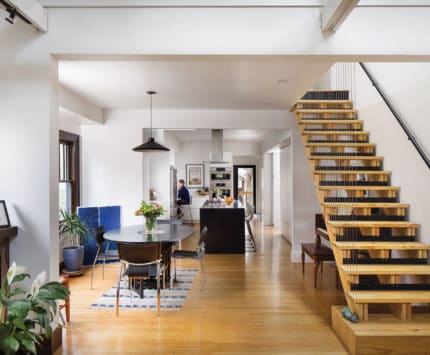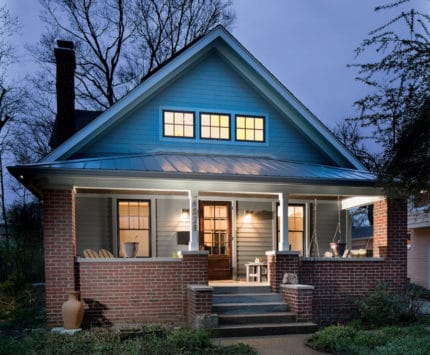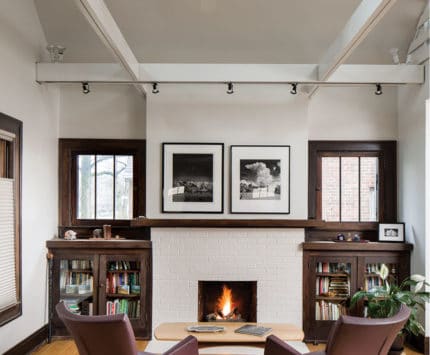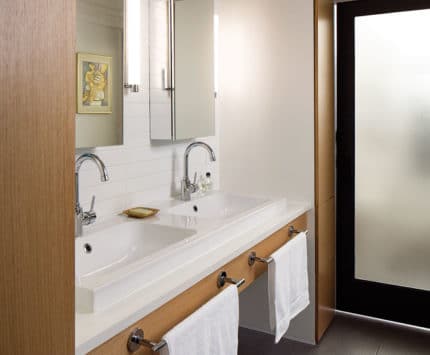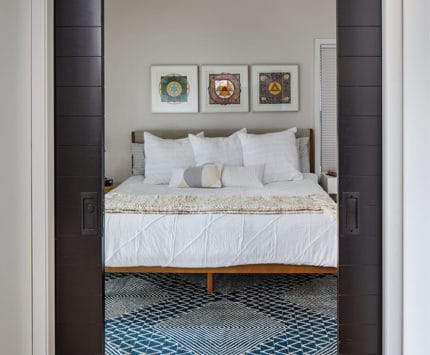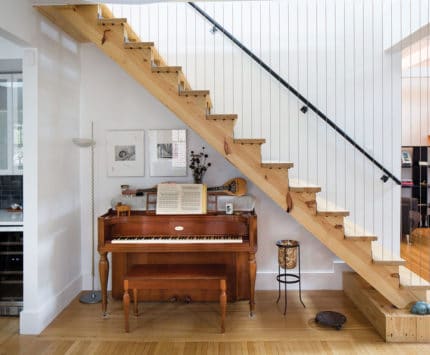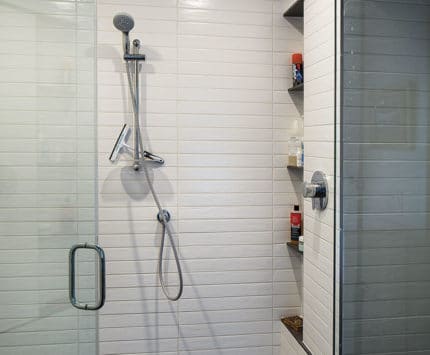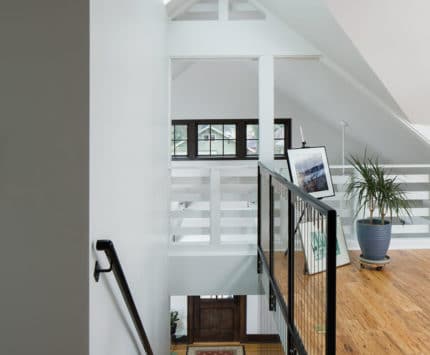Home Of The Month: Broad Ripple Bungalow
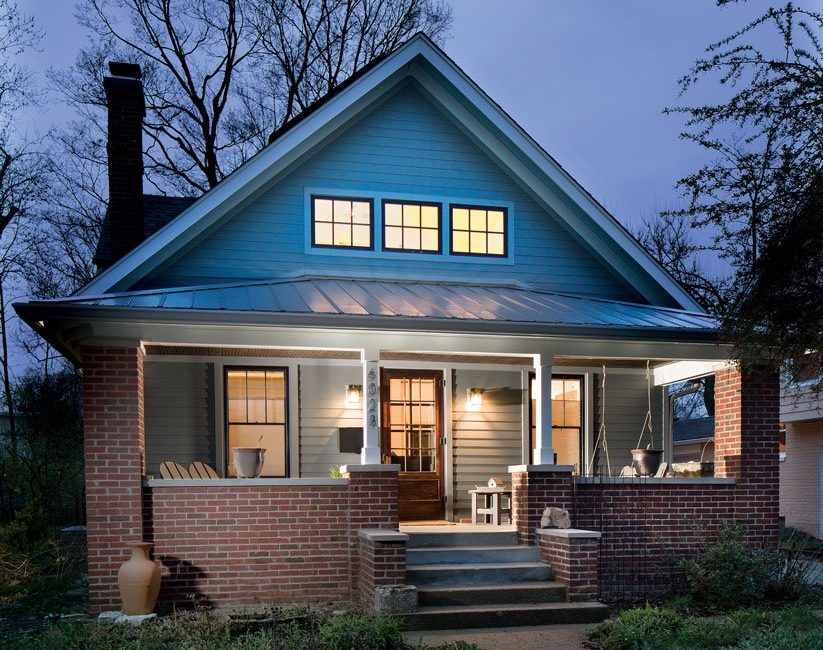
Lori Losee started thinking about “the bungalow of the future” during the 2014 Broad Ripple Historic Homes Tour. She and her husband, James Todd, were volunteering as docents at a Craftsman cottage just up the street. Haus, a local architecture studio, had worked on the home and had given it a contemporary yet playful vibe that resonated with Losee. For two years, she toyed with the idea of transforming her own home. Then she called Chris Short, principal architect at Haus, and asked, “Are you bored of Broad Ripple?” He said, “Let’s sit down.”
By the time they started working with Haus, Losee and Todd had lived in their 1926 home (then 1,372 square feet) for nearly three decades, attracted initially by the area’s walkability and central location. But the pair—who are kayakers, food lovers, and farmers market aficionados—knew their two-bedroom, one-bath bungalow wasn’t ideal for the long run. They needed a space where they could age in place. And for that, they needed Short.
“This is really about uncovering more potential within the footprint of the bungalow,” Losee says. “We had several design sessions with [Short] and had a vision about opening the upstairs and uncovering the stairwell. Instead of being chopped up into small rooms, we wanted to open the house up.”
And in doing so, not even the roof was spared.
Just days into the project, all that remained of the home were its four exterior walls. Even the deck was gone, cut off and given to a neighbor. The couple decamped to Butler-Tarkington to house-sit for friends of friends. By staying nearby, Losee, who works for a research center, and Todd, who is retired, were able to swing by the site every day as Haus raised the roof’s pitch to turn the attic into a livable second level. “We had this fantasy of being onsite helpers, but I think we helped more by being out of the way,” Losee says.
But Haus is highly collaborative, and its design, finished in eight months, caters to the couple’s lifestyle and life stories. Exposed hardware pays homage to Losee’s family, whose business manufactured metal components like truss plates. The piano, tucked beneath the open-air staircase, displays Todd’s mandolin collection on top. And the kitchen, once an enclosed 11-by-10-foot cube, now caters to the couple’s culinary ambitions with enough space for both owners to work simultaneously.

The homeowners were driven by their priorities at this stage of life: energy and space efficiency (Rectify Solar added panels to the roof). The new design affected them in ways they didn’t expect, too. “It’s a different feel, to see the height of the house,” says Lori Losee. “It’s so filled with light now, it makes us want to get up in the morning.” Haus encouraged a black-and-white palette to pick up the dark tones in the original woodwork.Photo by Tony Valainis
While two cooktops and two sinks didn’t fit into the budget, a wet bar, island seating, and an office nook did. The experience taught Losee this lesson for renovators: “Pick the activity that you love doing at home, and spend design time and resources on making it the best space that you can.”
The kitchen wasn’t the only room to receive special treatment. The master suite on the main level features a walk-in shower and doorways wide enough to accommodate all eventualities. The washer and dryer were moved up from the basement, and a skylight above the staircase bathes both the first and second floors in natural light. During the day, there’s no need for overhead lights or lamps; the sun’s rays reach into every room. The second floor, which added 680 square feet to the home, almost feels like a treehouse. In every direction, there is light, wood, nature, peeks of neighboring homes, and the geometry of the bungalow itself.
It’s inspiring how, even late into the afternoon, these features highlight the home’s black, white, and natural wood palette.
“We’re careful about the color pops we bring in,” Losee says. “The vision with [Short] was to focus on the windows and the tone of the natural wood.”
Downstairs, the trim, mantel, and fireplace—as well as the bookshelves that flank it—are all original to the home. Additional materials, such as doors, cabinets, and lighting and plumbing fixtures, were salvaged during the demolition process. Many of these elements were donated to small architectural-salvage groups, while some were reincorporated. One of the doors into the kitchen, as well as the original bathroom door, were turned into pocket doors on the second floor.
Honoring the home’s original iteration isn’t the only way Losee, Todd, and Haus extended this bungalow’s life. The design also incorporates LED lighting, energy-efficient appliances, solar panels, and low-amperage ceiling fans from New Zealand. But for all of these upgrades, when asked what she loves most about her light-filled home, Losee points to the windows surrounding the dining table. “When the sun comes through the glass, it creates all these abstract shapes on the wall,” she says. “I love the imperfections.”
- Photo by Tony Valainis
- Photo by Tony Valainis
- Photo by Tony Valainis
- Photo by Tony Valainis
- Photo by Tony Valainis
- Photo by Tony Valainis
- Photo by Tony Valainis
- Photo by Tony Valainis
- Photo by Tony Valainis

